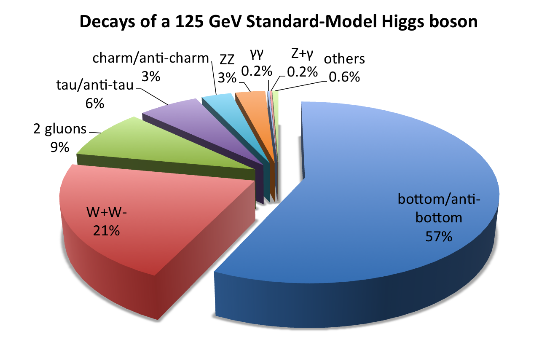The Higgs boson
The Higgs boson was the last particle of the Standard Model (SM) to be experimentally confirmed. In July 2012, the ATLAS and CMS experiments at CERN announced the discovery of a new boson at a mass of roughly 125 GeV which was compatible with the long-awaited Higgs boson.
The SM does not say how heavy the Higgs boson is. However, for a given Higgs mass the SM predicts how often it is produced in particle collisions and how it decays to the known particles. The following chart summarizes how often a 125 GeV Higgs decays to various final known particles.

Such a Higgs boson is very heavy, even heavier than the Z boson you have met before, and has a very short lifetime and, therefore, travels only a very tiny distance. There is therefore no chance to directly detect it in ATLAS or any other particle detector.
The Higgs boson can be produced at high-energy proton-proton collisions at the LHC. ATLAS and CMS have observed decays to (i) 2 Z bosons, leading to two pairs of charged leptons, to (ii) 2 photons, and to (iii) 2 W bosons, leading to 2 charged leptons and 2 neutrinos. Decays of the Higgs boson to tau lepton pairs has also recently been observed.
In this Z-path, you will have the chance to search for the Higgs decays (i) and (ii) above and partly repeat what the ATLAS physicists have done at CERN!
The particle discovered by ATLAS and CMS in 2012 is now usually referred to as "the Higgs boson". Several properties, including the spin, have been measured, and they are consistent with the Standard Model predictions. The decay of the Higgs boson to a pair of tau leptons has been observed, but the decay to a pair of bottom quarks remains to be confirmed.
But why is it so that “rare” decays such as H→γγ(with 0.2% probability) are observed, but not the “frequent” decays H→bb̅ (with 57% probability)? The latter decay of the Higgs leads to 2 jets of particles that are very difficult to separate from the much more abundant production of normal jets, those allowed by the strongest of all interactions – the strong force.
If you are patient you will, hopefully in future Masterclasses, study such Higgs decays. For now, good luck with your search for the Higgs boson in decays to ZZ and γγ.
Isn’t it marvelous that data which were used to discover the Higgs boson are available for you to analyze?
Follow this link in case you want to know more about the Higgs. In the Standard Model, to the Higgs field, which is responsible for particle masses, correspond the Higgs boson, which is a particle of spin 0. It is the latter that we have been searching for at the LHC!